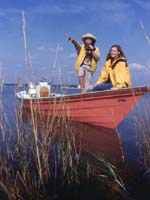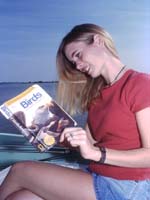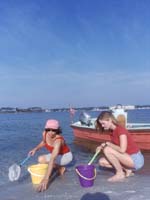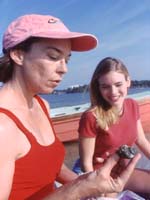
|
Features
|
|
|
|
Books
|
|
|
|
Fun & Games
|
|
|
|
Contact Us
|
|
|
John's Journal... Entry 98, Day 5
The Sand Islands
 EDITOR'S
NOTE: Former T.V. producer Joanne McDonough and her videographer husband
Lynn Rabren of Orange Beach, Alabama, live their dreams by conducting
private nature tours for visitors to the Gulf Shores area and by selling
their custom-built Caribiana boats as fast as they can build them. This
week, we'll talk to Joanne and learn how they've started their businesses,
why they've chosen to design and build their own boats, and what passengers
can expect to see and do on their island cruises.
EDITOR'S
NOTE: Former T.V. producer Joanne McDonough and her videographer husband
Lynn Rabren of Orange Beach, Alabama, live their dreams by conducting
private nature tours for visitors to the Gulf Shores area and by selling
their custom-built Caribiana boats as fast as they can build them. This
week, we'll talk to Joanne and learn how they've started their businesses,
why they've chosen to design and build their own boats, and what passengers
can expect to see and do on their island cruises.
Question: How did Perdido Pass get its name?
Answer: Spanish sailors who sailed great galleon ships all up and
down the Gulf Coast in the early to mid 1500s named Perdido Pass. They
could see a body of water back here but never could find a way in to it.
The pass didn't open up until the 1800s when a hurricane probably blew
it open. The Spanish sailors then came through the pass and named it Perdido
Pass and Perdido Bay -- which means "lost" in Spanish.
Question: What are the names of the other islands?
Answer: We also have Gilchrist Island, Bird Island, Walker Island
and Robinson Island just inside the pass by Alabama Point.
 Question:
What are some distinguishing factors about these islands?
Question:
What are some distinguishing factors about these islands?
Answer: They are sand-island communities formed by wave action
and storms. They are turtle grass habitat and house the blue crab, redfish
and a variety of small baitfish we find in the more shallow water. The
islands also have marshlands with spartina grasses, which have root systems
where small fish hide and survive while maturing. And then the sand islands
themselves are filled mainly with slash pine, long leaf pine and scrub
oak, which are the favorite nesting areas of pelicans and great blue herons.
Question: Joanne, tell me about the sand at Orange
Beach, Alabama. From where did it come?
Answer: Our sand is so white because it's made of crystalline quartz.
The only other place in America with crystalline quartz is in the Appalachian
Mountains. That means that over eons of time the quartz has been eroded
by rain, wind and storms and carried through rivers and underwater systems
and finally deposited right here in the Gulf of Mexico at Gulf Shores
and Orange Beach.
Question: So our sand/quartz comes out of Kentucky?
Answer: You can say that.
 Question:
Do you take your nature tours through the islands?
Question:
Do you take your nature tours through the islands?
Answer: Yes. After our visitors learn about Perdido Pass and where
it got its name and why our sand is so white, we go out into Perdido Bay,
the feeding grounds for the bottle-nosed dolphins. We also see where the
U.S. Army Corp of Engineers dug a channel in the 1940s to make the Intercoastal
Waterway, which created Pleasure Island and disconnected us. That waterway
is a major shipping channel for coal and wood that travels all the way
to south Florida, deep into the heart of Texas and even into St. Louis.
Then we take our passengers into the bayous where the rivers meet the
Gulf of Mexico. They can view wetlands and marshlands and then maritime
forests and see where the grassy areas eventually give way to cypress
and cedars.
Question: What do you see in there?
Answer: You'll see a lot of beauty without any development.
Question: What animals or birds do you see?
Answer: We also see dolphins, osprey and kingfishers. I have seen
deer there in the fall and winter months. You will see pelicans and peregrine
falcons at a particular time of the year. You also can spot a variety
of wading birds such as the elegant egrets, blue herons and tri-colored
herons.
Question: This location is a photographer's paradise,
right?
Answer: It really is. The pictures you can take here -- just about
any time of the day -- are phenomenal. And the memories that you bring
back are absolutely beautiful.
 Question:
Do you have any educational programs set up in the Orange Beach area?
Question:
Do you have any educational programs set up in the Orange Beach area?
Answer: There's the Pelican's Nest at the Fairhope K-1 Center.
The Fairhope Educational Foundation has raised money from private sources
and then has received matching funds from the county and the schools to
build a science-and-technology lab for children. We've given them research
tools, cameras and nets and taken some kindergartners and first graders
down to the bay to search for various creatures. The children bring a
few critters back to the lab and look at them through their microscopes.
Question: Do you provide field trips?
Answer: No, but the project does. Groups as far away as Monroeville,
Alabama, bring their classes and go out with Charlene Dindo, the director,
and spend the day on the bay looking for different creatures and learning
about the Pelicans. Inside the Pelican's Nest they use aquariums and microscopes
to study the animals. We even have underwater microscopes they can look
through at the animals.
Question: Can other school systems take advantage
of this program?
Answer: The Pelican's Nest is mainly focusing on the Baldwin County
Schools, but I believe other school systems can use it.
For more information about Caribiana, visit the website at www.caribiana.com, or, call (888) 203-4883 or (334) 981-4442.
To learn more about the Gulf Shores/Orange Beach area -- restaurants, attractions, birding opportunities, hotels, condos, fishing captains -- call the Alabama Gulf Coast Convention and Visitors Bureau (AGCCVB) at (800) 745-7263, or visit the website at www.gulfshores.com.
Check back each day this week for more about Caribiana Island Cruises ...
Day 1 -Caribiana Island
Cruises
Day 2 -How Caribiana Island Cruises Began
Day 3 -The Caribiana Boats
Day 4 -Orange Beach's Flora and Fauna
Day 5 -The Sand Islands